Related Research Articles

The Dinorwig Power Station, known locally as Electric Mountain, is a pumped-storage hydroelectric scheme, near Dinorwig, Llanberis in Snowdonia national park in Gwynedd, northern Wales. The scheme can supply a maximum power of 1,728-megawatt (2,317,000 hp) and has a storage capacity of around 9.1 GWh (33 TJ).
India is the world's third largest producer and third largest consumer of electricity. The national electric grid in India has an installed capacity of 368.79 GW as of 31 December 2019. Renewable power plants, which also include large hydroelectric plants, constitute 34.86% of India's total installed capacity. During the 2018-19 fiscal year, the gross electricity generated by utilities in India was 1,372 TWh and the total electricity generation in the country was 1,547 TWh. The gross electricity consumption in 2018-19 was 1,181 kWh per capita. In 2015-16, electric energy consumption in agriculture was recorded as being the highest (17.89%) worldwide. The per capita electricity consumption is low compared to most other countries despite India having a low electricity tariff.
The electricity sector in Canada has played a significant role in the economic and political life of the country since the late 19th century. The sector is organized along provincial and territorial lines. In a majority of provinces, large government-owned integrated public utilities play a leading role in the generation, transmission and distribution of electricity. Ontario and Alberta have created electricity markets in the last decade in order to increase investment and competition in this sector of the economy.
Snowy Hydro Limited is an electricity generation and retailing company in Australia that owns, manages, and maintains the Snowy Mountains Hydro-electric Scheme which consists of nine hydro-electric power stations and sixteen large dams connected by 145 kilometres (90 mi) of tunnels and 80 kilometres (50 mi) of aqueducts located mainly in the Kosciuszko National Park. Snowy Hydro also owns and operates two gas-fired power stations in Victoria and one in New South Wales, three diesel power stations in South Australia, and owns two electricity retailing businesses.

Trustpower Limited is a New Zealand electricity generation and electricity retailing company, listed on the New Zealand stock exchange.
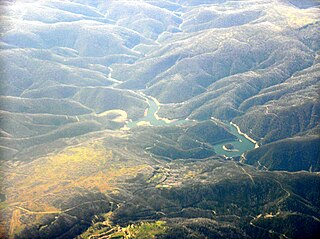
Tumut Hydroelectric Power Station is a series of three of the original four, now five hydroelectric power stations on the Tumut River in New South Wales, Australia, that are part of the Snowy Mountains Scheme.
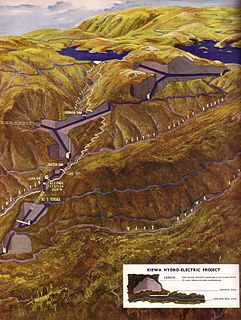
The Kiewa Hydroelectric Scheme is the largest hydro-electric scheme in the Australian state of Victoria and the second-largest in mainland Australia after the Snowy Mountains Scheme. The scheme is situated in the Australian Alps in north-eastern Victoria about 350 kilometres from Melbourne and is wholly owned by AGL Energy.
The energy policy of India is largely defined by the country's expanding energy deficit and increased focus on developing alternative sources of energy, particularly nuclear, solar and wind energy. India ranks 81 position in overall energy self-sufficiency at 66% in 2014.
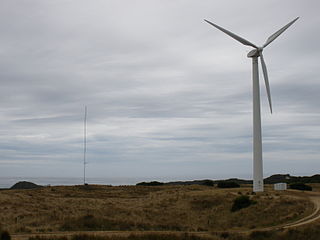
Huxley Hill Wind Farm is a wind power station at King Island, Tasmania, Australia, of around 1600 residents, owned by Hydro Tasmania, which supplements the four diesel generators with a combined capacity of 6 MW at Currie Power Station. King Island also has a 100 kW solar capacity provided with monocrystaline solar panels on dual-axis arrays.

AGL Energy Ltd is an Australian listed public company involved in both the generation and retailing of electricity and gas for residential and commercial use.

Contact Energy Limited is a New Zealand electricity generator, natural gas wholesaler and electricity, natural gas, broadband and LPG retailer.

Renewable energy in Australia includes wind power, hydroelectricity, solar PV, heat pumps, geothermal, wave and solar thermal energy.
The Whirinaki Power Station is an open cycle gas turbine power station at Whirinaki, Hawke's Bay in New Zealand.
Tamar Valley Power Station is a $230 million natural gas-fired power station located in Bell Bay in the Tamar Valley, Tasmania. It is owned by Hydro Tasmania, and is immediately adjacent to the decommissioned Bell Bay Power Station, which is also owned by Hydro Tasmania.
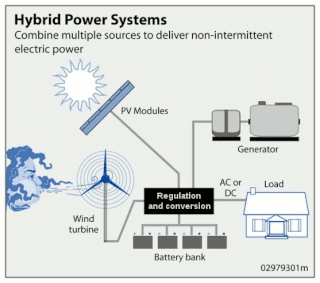
Wind hybrid power systems combines wind turbines with other storage and/or generation sources. One of the key issues with wind energy is its intermittent nature. This has led to numerous methods of storing energy.
Angaston Power Station is a diesel-powered electricity generator in the Barossa Valley region of South Australia near the town of Angaston. It is owned and operated by Snowy Hydro since 2014. It consists of 30 diesel reciprocating engines generating up to 50 MW of electricity to meet peak demands in the National Electricity Market.
Port Stanvac Power Station is a diesel-powered electricity generator in South Australia in Lonsdale, an industrial southern suburb of Adelaide. It is owned by Snowy Hydro since 2014. It consists of 36 diesel engines each generating 1.6MW for a total of 58MW of electricity to meet peak demands in the National Electricity Market.
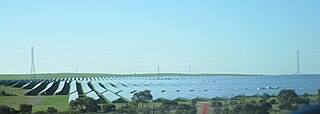
The Tailem Bend Solar Power Project is a solar power farm near Tailem Bend in South Australia. It has 108MW of generation capacity but is limited to supplying 95MW to the national grid. An additional 85MW is proposed in stage 2. It is developed and owned by Singapore-based Vena Energy, a new name for the former Equis Energy following acquisition by Global Infrastructure Partners in January 2018. The output will be sold to Snowy Hydro for retail sale under its Lumo Energy brand. Stage 2 is also expected to provide battery storage.
Temporary Generation South and its larger sibling Temporary Generation North are gas turbine power stations in South Australia. They were bought by the Government of South Australia in 2017 as a response to the 2016 South Australian blackout and load-shedding in February 2017.
References
- ↑ "Generation Information SA". Australian Energy Market Operator. 22 December 2017. Retrieved 24 January 2018.
- ↑ "Standby power" (PDF). Cummins Power Generation. 17 December 2009. Archived from the original (PDF) on 28 March 2018. Retrieved 23 January 2018.
- ↑ "Our Diesel Assets". Snowy Hydro . Retrieved 23 January 2018.
- ↑ "Lonsdale Power Station". SDA Engineering . Retrieved 23 January 2018.
| This article about an Australian power station is a stub. You can help Wikipedia by expanding it. |